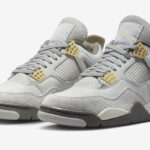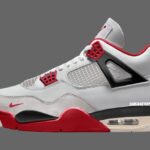“`html
Air Jordan 4 Fear: Price Guide, Deals, and How to Cop Legit
The Air Jordan 4 “Fear” is a highly sought-after sneaker that was originally released in August 2013 as part of the “Fear Pack,” which also included an Air Jordan 3 and Air Jordan 5. The pack was inspired by Nike’s 2008 “Become Legendary” marketing campaign and the emotion of fear that athletes must overcome. When it comes to purchasing coveted sneakers like these, “price comparison is crucial as it helps buyers ensure they are getting the best possible value for their money and avoid overpaying.”
Retailer Comparison: A Look Back
When the Air Jordan 4 “Fear” first dropped in 2013, its retail price was approximately $175 USD. However, as a limited release from over a decade ago, you won’t find these sneakers sitting on the shelves of standard retailers like Foot Locker, Nike.com, or Finish Line today. The “Fear” 4s are now exclusively found on the resale market, as they are considered a “deadstock” (no longer in production) item.
Resale Market Analysis: What to Expect
The resale market is where the hunt for the Air Jordan 4 “Fear” truly begins. Prices can vary significantly based on several factors:
- Condition: Deadstock (DS) pairs, meaning brand new, unworn, and in the original box with all accessories, command the highest prices. Pre-owned pairs will be cheaper, with the price heavily dependent on the level of wear and tear, and whether the original box is included.
- Size: Popular sizes (e.g., US 8-11) often have more availability but can also be in higher demand, sometimes leading to slightly higher prices. Less common sizes might be harder to find but could occasionally be priced lower or higher depending on scarcity.
- Platform:
- StockX: This is a live “bid/ask” marketplace. As of late 2023 / early 2024, prices for new, authenticated pairs of Air Jordan 4 “Fear” typically range from around $450 to $800+, depending heavily on size. The platform authenticates every pair sold.
- GOAT: Similar to StockX, GOAT offers new and used pairs with authentication. Prices for new pairs often fall within a similar range of $500 to $850+. Used pairs can be found for less, often starting around $250-$350 depending on condition.
- eBay: A wider range of prices and conditions can be found here. You might find a deal, especially on used pairs or auctions. However, authentication is key. eBay’s “Authenticity Guarantee” service for sneakers (where available and for eligible listings) provides an extra layer of security, with prices often aligning with StockX and GOAT for authenticated new pairs.
- Hype and Rarity: As a well-regarded and somewhat limited colorway from the past, the “Fear” 4s maintain strong demand among collectors and enthusiasts, keeping prices significantly above the original retail.
Generally, expect to pay a substantial premium over the original retail price. For a new, authenticated pair in good condition with the original box, budgeting at least $500 is a realistic starting point, with many common sizes pushing towards $600-$700 or more.
Tips for Finding the Best Deals on Air Jordan 4 Fear
Scoring a “deal” on such a popular retro sneaker requires patience, diligence, and strategy:
- Compare Across Platforms: Don’t limit your search to one site. Check prices for your specific size on StockX, GOAT, and eBay to get a comprehensive view of the current market.
- Set Price Alerts: Many platforms (like StockX and GOAT) allow you to set price alerts for specific sneakers in your size. You’ll be notified if the price drops to your desired level or if new listings appear.
- Consider Used or “VNDS”: If you’re okay with a pair that’s not brand new, you can often save a significant amount. Look for pairs listed as VNDS (Very Near Deadstock) or PADS (Pass As Deadstock), which are typically worn lightly. Always check photos carefully.
- Be Patient & Monitor Fluctuations: Sneaker resale prices can fluctuate based on overall market trends, new releases, and even time of year. If you’re not in a rush, monitor prices for a while.
- Look for Reputable Individual Sellers: Sometimes, sellers on platforms like eBay, or in dedicated Facebook sneaker groups or local consignment shops, might offer slightly better prices. However, the risk of fakes is higher, so vetting the seller and the product is paramount.
- Factor in All Costs: Remember to include marketplace fees (like StockX’s processing fee), shipping costs, and potential sales tax or import duties (if buying internationally) when comparing final prices.
- Beware of “Too Good to Be True” Deals: If a price seems drastically lower than the market average, especially for a new pair, it’s a major red flag for a counterfeit product or a scam.
Authenticity Guide: Spotting Fake Air Jordan 4s
With high resale prices come the unfortunate reality of counterfeit sneakers. Here are key areas to inspect on Air Jordan 4s (and specifically to keep in mind for the “Fear” colorway, which has a distinct Black/White-Cool Grey-Pure Platinum scheme and nubuck/suede upper):
- Box and Label:
- Ensure the box label details (style code, size, colorway name, production dates) match the shoe and official records. The style code for the Air Jordan 4 “Fear” is 626969-030.
- Font, print quality, and label placement should be crisp and accurate.
- Overall Shape and Proportions:
- Familiarize yourself with the correct silhouette. Fakes often have a bulky or misshapen toe box, incorrect heel shape, or wrong tongue height.
- The “stance” of the shoe should look right.
- Stitching Quality:
- Authentic pairs feature neat, consistent, and tight stitching throughout the upper. Loose threads, sloppy lines, or uneven stitching are red flags.
- Tongue Tag:
- The “Flight” script and Jumpman logo on the exterior of the tongue tag should be well-defined, with clean embroidery.
- The stitching around the tag itself should be neat.
- The reverse of the tongue tag should have “AIR JORDAN” embroidered upside down, cleanly.
- Netting/Mesh:
- The plastic netting on the side panels and at the base of the tongue should be correctly angled (often diagonally, not straight up and down), feel durable, and have consistent spacing. On the “Fear” 4s, this netting is black.
- Heel Tab and Logo:
- The plastic heel tab should be sturdy. The Jumpman logo molded onto it should be well-defined with sharp edges, not blurry or poorly molded. The “Fear” 4 features a speckled grey heel tab with a white Jumpman.
- Material Quality:
- The Air Jordan 4 “Fear” primarily uses a dark grey (almost black) nubuck/suede on the upper. Authentic materials have a distinct premium feel and texture. Fakes often use cheaper, lower-quality synthetics that may look or feel off.
- The midsole speckling (grey on black) should be consistent and correctly applied.
- Lace “Wings” and Eyelets:
- The plastic “wings” that hold the laces should be made of quality plastic and correctly shaped. The lace eyelets should be cleanly punched.
- Insole and Footbed:
- Check the insole print (Jumpman logo or Nike Air, depending on the retro) for quality. Underneath the insole, the stitching on the footbed (strobel board) should be neat.
- Smell:
- Authentic Nike/Jordan sneakers have a specific factory smell. A strong, overpowering chemical or glue smell can be an indicator of a counterfeit pair.
- Purchase from Reputable Sources: The best way to avoid fakes is to buy from established resale platforms like StockX or GOAT that offer authentication, or from highly reputable consignment stores and sellers with strong, verifiable track records. If using eBay, prioritize listings with the “Authenticity Guarantee.”
Conclusion: Getting Your Hands on the Fear
The Air Jordan 4 “Fear” is a really cool shoe, but because it’s older, it costs a lot more now than when it first came out. You can’t buy it in regular shoe stores anymore. You have to find it online from sellers on sites like StockX or GOAT, where people sell shoes they own. Prices for a new pair can be from $450 to over $800, which is a lot! To try and get a better price, look on different websites, and maybe think about buying a pair that someone has worn just a little bit. You need to be super careful about fake shoes, so make sure the shoe details look right and always try to buy from places that check if the shoes are real. Getting these special sneakers takes time and saving money, but they are a very awesome pair to own if you’re a fan!
“`



